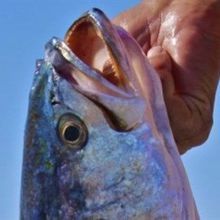Login
Subscribespawning

Infographic: An Incredible Journey
Christie Wilcox, PhD | Feb 1, 2023 | 1 min read
Chinook make their way up the Klamath River every year, but fewer and fewer arrive in the spring.

Timeline: An Extended Battle
Christie Wilcox, PhD | Feb 1, 2023 | 3 min read
Various concerned groups have been petitioning NOAA Fisheries to list spring-run Chinook salmon in Oregon and Northern California for over a decade.

Slideshow: Restoring Coral Reefs
Hanna R. Koch, Erinn Muller, and Michael P. Crosby | Feb 1, 2021 | 2 min read
By growing mountainous star corals in the lab and outplanting them to dying reefs, we were able to grow sexually mature corals that could help reef recovery.

Restored Corals Spawn Hope for Reefs Worldwide
Hanna R. Koch, Erinn Muller, and Michael P. Crosby | Feb 1, 2021 | 10+ min read
Novel technologies establish a new paradigm for global coral reef restoration, with in situ spawning of mature, environmentally resilient corals in five years instead of decades.

Infographic: How to Accelerate the Growth of Restored Corals
Hanna R. Koch, Erinn Muller, and Michael P. Crosby | Feb 1, 2021 | 2 min read
Our novel technique involves planting several small fragments of slow-growing corals onto dead coral heads. The fragments eventually fuse, forming a large colony in a fraction of the time that it takes wild corals to build reefs.

European Eels Strew Their Eggs Across 2,000 Km of Ocean
Shawna Williams | Apr 23, 2019 | 4 min read
The fish continue to spawn over a large area despite a drop in their numbers, a study finds.

As Disease Batters Florida Reefs, Scientists and Community Fight Back
Carolyn Wilke | Apr 4, 2019 | 6 min read
Stony coral tissue loss disease has already affected 80 percent of Florida’s coastal reef system. Now, a huge team of responders is working to slow its spread and prepare for future restoration efforts.

Spotted Seatrout Continued to Spawn During and After Hurricane Harvey
Jef Akst | Nov 16, 2018 | 2 min read
Researchers recovered audio recordings of the fish’s mating calls in the eye of the storm.

Sound of the Day: Big Mouth Gulf Corvina
The Scientist Staff and The Scientist Staff | Dec 20, 2017 | 1 min read
Researchers document the loudest sound ever recorded in fish.

Behavior Brief
Jenny Rood | May 21, 2015 | 6 min read
A round-up of recent discoveries in behavior research
A Gamete Matchmaker
Hannah Waters | Mar 22, 2012 | 3 min read
Chemical cues dispersed by mussel eggs may attract sperm that are their perfect match.
